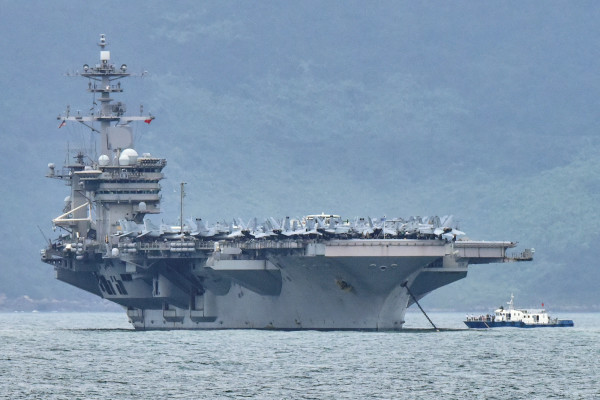

Despite what Defense Secretary Mark Esper has said recently, ships at sea may not be the safest place to be during the novel coronavirus (COVID-19) pandemic.
On Monday, Esper said that only two out of more than 90 Navy ships that are currently at sea have experienced coronavirus outbreaks, in part because the Navy tests and quarantines sailors before ships head out.
“The statistics show that the safest place to be is on a deployed Navy ship as compared to one that’s in port,” Esper said as part of a webinar with the Brookings Institution think tank in Washington, D.C.
However, an April 30 Defense Health Agency report appears to contradict Esper on this matter.
The report notes that, “DoD shipboard populations are at increased risk of COVID-19,”citing the outbreaks aboard the aircraft carrier USS Theodore Roosevelt and the destroyer USS Kidd.
As of April 30, 1,102 sailors aboard the Theodore Roosevelt and 78 sailors on the Kidd had tested positive for the coronavirus, according to the Navy, which has since stopped providing daily updates on the number of sailors aboard both ships with COVID-19.

After this story was initially published on Thursday, Pentagon spokesman Jonathan Hoffman provided Task & Purpose with a statement about Esper’s remarks about ships being safe as well as the April 30 Defense Health Agency report.
“The secretary made a simple, obvious and irrefutable statistical point: more ships at port have had positive cases than ships at sea,” Hoffman said. “This has been widely reported and isn’t a controversial or debatable fact at this point.”
“The surveillance summary is reflective of a situation where unscreened or untested personnel might embark on a ship,” Hoffman continued. “Increased testing capabilities and quarantine protocols have changed the equation dramatically and have mitigated those risks significantly.”
Speaking to reporters on Tuesday, Esper said it is possible that the Kidd’s crew became infected with the coronavirus during a counter-narcotics operation.
“A theory is that they could have picked it up on a counter-drug mission, where they pulled over a vessel possibly carrying drugs, and they board the vessel and may have come in contact with somebody carrying the virus there,” Esper said at a Pentagon news briefing.
At the same briefing, the chairman of the Joint Chiefs of Staff said the Navy has introduced “quite strict” protocols that include isolating sailors for up to 21 days before getting underway to reduce the risk of crews becoming sickened by the coronavirus.
“I’m very, very confident the Navy’s instituted some very disciplined and rigorous protocols to protect the sailors on board the ship as they embark,” said Army Gen. Mark Milley.
However, Politico reporter Lara Seligman has recently reported that sailors who have returned to the Theodore Roosevelt from isolation have shown symptoms of the coronavirus. The Navy claims that all crew members are required to test negative at least twice before being allowed back on the aircraft carrier.
That said, the Theodore Roosevelt’s former commanding officer warned his superiors shortly before he was fired that testing cannot prove that a sailor does not have the virus.
“As an illustration, of the first 33 TR sailors diagnosed with COVID-19, 21% (7 of those 330 infected sailors were negative on a COVID-19 test, then subsequently presented with symptoms of COVID-19 infection within 1-3 days post-test,” wrote Navy Capt. Brett E. Crozier in his March 30 memo, which he sent to commanders in U.S. Pacific Fleet.

Crozier also noted that the close quarters aboard warships made it impossible for the Theodore Roosevelt’s sailors to practice social distancing. For that and other reasons, Crozier said the only way to stop the spread of the disease aboard the ship was to move the majority of the crew to individual quarantine ashore.
“We are not at war,” Crozier wrote. “Sailors do not need to die.”
In a message to the fleet, Chief of Naval Operations Adm. Mike Gilday told sailors on Wednesday that the Navy will continue to deploy ships during the coronavirus pandemic.
“We cannot simply take a knee or keep everyone in port until this enemy is defeated,” Gilday said. “We are America’s away team. The uncertainty caused by COVID-19 makes our mission of protecting America at sea more important than ever. That is why the U.S. Navy continues to operate forward every day.”
The measures taken by the Navy to reduce the spreading disease must become the new normal because fleet operations depend on sailors remaining healthy, Gilday said.
Gilday also cautioned that the Navy may have to deal with another round of the coronavirus.
“Continue to gather lessons learned at all levels, and prepare for another wave of COVID so that we can minimize the impact and be prepared, if that happens,” he wrote.
UPDATE: This story was updated on May 7 to include a statement from Pentagon spokesman Jonathan Hoffman.
